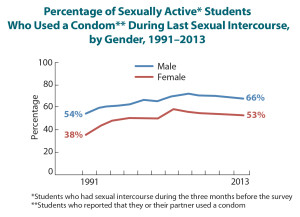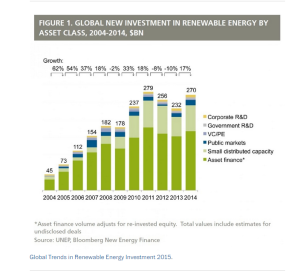More than 5 billion condoms are sold each year. In fact, it was estimated that in 2005, 10.4 billion condoms were used world-wide. As you can see by the graph below, condom usage has been increasing over the years:

[Amongst males it has grown 66 – 54 = 12 % and females it has grown 53 – 38 = 15 %]
We’ve all grown up learning of safe sex practices and that condoms not only prevent pregnancies, but also against most STI’s. That being said, condoms are not biodegradable, cannot be flushed as they don’t disintegrate in water, and cannot be recycled. Condoms are taking up a decent portion of our landfills.
That being said, the positive effects of condoms outweigh the piles sitting in landfills. The biggest impact they’ve had is allowing the environmental revolution to be possible as the simplest form of birth control. Birth Control not only helps to keep the population at bay, but it reduces unplanned pregnancies which allow women wo aren’t in the position to be a mother, have a career or finish school.
Another way condoms are environmentally friendly is that they actually help save the Rainforest! According to the Rainforest-Alliance, cattle ranchers and rubber trappers disagree over rights to clear forest land. Rubber tapping is a completely sustainable practice and many countries in the Amazon, like Brazil, have sectioned off specific areas for rubber trappers to have that cannot be cut down, which is great seeing as 75% of Brazil’s Carbon Dioxide emissions came from deforestation.
according to this article, rubber trees can be harvested for 25 years or more and a high grade tree yields about 30 pounds of rubber a year. According to NPR, a tree can produce about 100,000 condoms.
This means that:
[(100,000 condoms produced by one tree)/(25 years of production)] = 4, 000 condoms produced a year per tree.
This brings us to the green condom. Many companies are starting to market a ‘Green Condom.’ For some companies this means using independent factories that were built specifically to use latex from rubber trees in the rainforests, for others it means less chemicals in condoms in order to, hopefully, find a way to have them biodegrade, or maybe even just a more eco-friendly package. Either way, according to Forbes, with the wy our society is starting to lean towards wanting everything in our lives to be as sustainable and ‘green’ as possible, it is a smart move for those ‘green’ condom companies to enter into this $1 billion-dollar-a-year market.
I think that it is smart for these smaller companies to be coming into the market with greener ways for safe sex. We all look for what is most sustainable, whether it be a reusable water bottle, or an electric car- why can’t we be green in every aspect of our lives? As a society we are all quick to talk about the next green thing- so why can’t we talk about the next generation of green condoms too? Especially since they bring awareness to saving the Rainforest!




